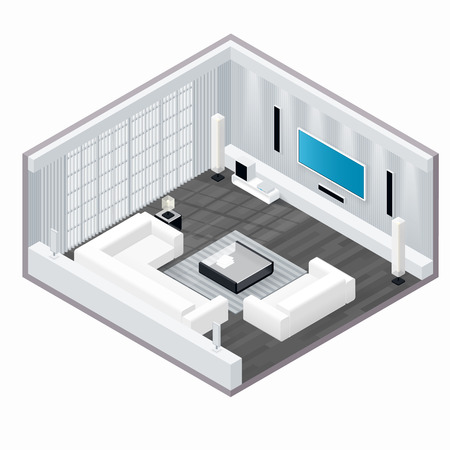Understanding Smart Lighting Ecosystems
When it comes to upgrading your home, smart lighting has quickly become a must-have for families seeking both convenience and style. But before you dive into the world of automated lights, its essential to understand what a smart lighting ecosystem actually is—and why it’s so important for modern American homes. Essentially, a smart lighting ecosystem refers to an interconnected network of bulbs, switches, sensors, and controllers that can be managed from your smartphone, voice assistant, or even automatically based on your daily routine. This system allows you to customize your homes ambiance with just a tap or voice command, whether youre hosting a cozy movie night or need bright light for homework sessions at the kitchen table. More than just a tech trend, smart lighting ecosystems are about creating an environment that adapts to your familys needs while saving energy and enhancing security. Choosing the right ecosystem ensures all your devices work together seamlessly, setting the foundation for a smarter, more comfortable home.
Popular Smart Lighting Platforms in the U.S.
When it comes to choosing a smart lighting ecosystem for your American home, it’s important to know which platforms are leading the way and what sets them apart. Let’s take a closer look at three of the most popular smart lighting systems: Philips Hue, LIFX, and GE Cync. Each offers unique features tailored to different needs, lifestyles, and homes across the United States.
Philips Hue
Philips Hue is one of the most recognized names in smart lighting. Its extensive compatibility with major smart home assistants—like Amazon Alexa, Google Assistant, and Apple HomeKit—makes it a go-to choice for many households. Philips Hue stands out for its robust app, reliable connectivity through the Hue Bridge, and a wide range of bulb types and fixtures that cater to every room in your house. The system is ideal for families looking for flexibility, scalability, and seamless integration with other smart devices.
LIFX
LIFX lights connect directly to Wi-Fi, eliminating the need for a separate hub or bridge. This makes setup simple and reduces clutter—a big plus in busy American homes. LIFX bulbs are known for their vibrant colors and high brightness levels, making them perfect for creative lighting scenes and parties. Compatibility includes Alexa, Google Assistant, Apple HomeKit, and even integrations with IFTTT for advanced automations. If you love high-tech features without extra hardware, LIFX might be your best fit.
GE Cync (formerly C by GE)
Designed with American families in mind, GE Cync offers both Bluetooth and Wi-Fi connectivity options. Its standout feature is user-friendly controls via the Cync app and voice control through Alexa or Google Assistant—no hub required! GE Cync’s product line covers everything from bulbs to switches and motion sensors, making it an excellent option if you want to gradually upgrade your home’s lighting without investing in a central hub right away.
Comparison Table: Top Smart Lighting Platforms
| Platform | Hub Required | Main Connectivity | Voice Assistant Support | Key Features |
|---|---|---|---|---|
| Philips Hue | Yes (Hue Bridge) | Zigbee & Bluetooth | Alexa, Google Assistant, Apple HomeKit | Extensive ecosystem, strong app support, broad compatibility |
| LIFX | No | Wi-Fi | Alexa, Google Assistant, Apple HomeKit | No hub needed, vivid colors, advanced automations |
| GE Cync | No (for basic use) | Bluetooth & Wi-Fi | Alexa, Google Assistant | User-friendly app, gradual expansion possible, affordable entry point |
What Makes These Platforms Stand Out?
The American market values flexibility and ease of use—these platforms deliver just that. Whether you prioritize seamless integration with your existing smart home devices (Philips Hue), crave simplicity with no extra hubs (LIFX), or want budget-friendly options that grow with your needs (GE Cync), there’s a solution tailored for every lifestyle. Understanding these differences is key when choosing a smart lighting ecosystem that will brighten up not only your rooms but also your daily life.

3. Compatibility with Voice Assistants and Smart Hubs
When building a smart lighting ecosystem for your home, it’s crucial to make sure your lights work seamlessly with the voice assistants and smart hubs you already use—or plan to add in the future. Not all lighting platforms are created equal, and their compatibility with popular systems like Alexa, Google Assistant, Apple HomeKit, and other smart home hubs can make or break your connected experience.
Alexa: The Versatile Choice
If you’re an Amazon household, many leading smart lighting brands such as Philips Hue, LIFX, and TP-Link Kasa are designed to sync effortlessly with Alexa. With simple voice commands like “Alexa, turn off the kitchen lights,” you gain hands-free control that’s perfect for busy families or when your hands are full. Plus, Alexa’s Routines feature lets you automate lighting based on schedules or triggers from other smart devices.
Google Assistant: Seamless Integration Across Devices
Google Assistant is another major player, especially if you’re already invested in Nest products or Android devices. Most major lighting ecosystems offer native support for Google Assistant, enabling features like “Hey Google, dim the living room lights.” The integration goes even deeper if you use Google Home hubs, allowing custom routines and unified control across your home—no matter what device you’re using.
Apple HomeKit: For the Privacy-Conscious and Apple Fans
Apple HomeKit appeals to families who want tight security and privacy controls within their Apple-centric homes. While fewer lighting brands support HomeKit natively compared to Alexa or Google Assistant, options like Nanoleaf, Eve, and Philips Hue provide smooth integration. You can use Siri to control your lights by voice or set up automation through the Home app that works across iPhone, iPad, and Apple Watch.
Other Smart Hubs: Expanding Your Options
Beyond voice assistants, consider compatibility with smart home hubs like Samsung SmartThings or Hubitat. These platforms can connect a broader array of devices—including sensors and switches—into one cohesive system. If you’re aiming for advanced automation or have a mix of smart gadgets from different brands, double-check that your chosen lighting ecosystem supports these hubs.
Final Thought: Mix-and-Match Carefully
Ultimately, picking a smart lighting platform that fits into your family’s tech landscape ensures convenience now—and flexibility for future upgrades. Before making a purchase, review which voice assistants and hubs each brand supports. A little research up front saves you plenty of headaches later and sets your home up for easy living with just the right glow.
4. Connectivity: Wi-Fi, Bluetooth, Zigbee, and Beyond
When choosing a smart lighting ecosystem for your home, understanding the different wireless protocols is essential. The way your bulbs, switches, and hubs communicate affects everything from installation to daily use and future expansion. Let’s break down the main connectivity options—Wi-Fi, Bluetooth, Zigbee, and others—to help you make the smartest choice for your family.
Wi-Fi: Ubiquitous and Powerful
Wi-Fi-enabled smart lights connect directly to your home network. This means you can control them from anywhere with an internet connection—perfect for busy families who want remote access. Wi-Fi offers robust performance and easy integration with voice assistants like Alexa or Google Assistant. However, adding too many devices can strain your router, potentially slowing down other connections.
Bluetooth: Simple and Localized
Bluetooth smart lights are super easy to set up—just pair them with your phone or tablet. They’re ideal for apartments or smaller homes where long-range coverage isn’t necessary. But keep in mind, Bluetooth’s limited range means you need to be nearby to control your lights unless you have a dedicated hub acting as a bridge to the internet.
Zigbee: Reliable Mesh Networking
Zigbee is a popular choice for larger homes or anyone planning an extensive smart lighting setup. It creates a mesh network where each device relays signals to others, extending coverage and reliability. Zigbee devices require a compatible hub (like Philips Hue Bridge), but they free up your Wi-Fi bandwidth and offer excellent scalability.
Other Protocols: Z-Wave & Thread
While not as common for lighting alone, Z-Wave and Thread are worth mentioning. Both provide mesh networking similar to Zigbee. Thread is especially interesting as it supports Matter—a new universal standard aiming to unify smart home devices across brands.
Wireless Protocol Comparison Table
| Protocol | Range | Setup Complexity | Internet Required? | Best For |
|---|---|---|---|---|
| Wi-Fi | Whole house (depends on router) | Easy | Yes (for remote access) | Remote control, integration with other devices |
| Bluetooth | Room-to-room (short range) | Easiest | No (local only) | Apartments, renters, simple setups |
| Zigbee | Whole house (mesh network) | Moderate (needs hub) | No (with local hub) | Larger homes, scalability |
| Z-Wave/Thread | Whole house (mesh network) | Moderate (needs hub/controller) | No (with local controller) | Advanced users, future-proofing with Matter support |
The Bottom Line: Future-Proof Your Home
Your choice of wireless protocol will shape how flexible and reliable your smart lighting system is—today and tomorrow. For most American families wanting a balance of convenience and scalability, mixing protocols through bridges or hubs can bring out the best in each technology. As standards like Matter gain momentum, cross-brand compatibility will get easier—but it all starts with picking the right foundation for your family’s needs.
5. Future-Proofing and Interoperability
When it comes to smart lighting, thinking ahead is just as important as meeting your needs today. The technology in our homes keeps evolving, so future-proofing your smart lighting ecosystem can save you both time and money down the line. Here’s how you can choose a system that grows with your family’s needs and keeps up with emerging tech trends.
Look for Open Standards
Choose a smart lighting system that supports open standards like Matter or Zigbee. These protocols are designed to encourage compatibility among different brands and devices, so when the next must-have gadget hits the market, you’re more likely to integrate it smoothly into your existing setup.
Check for Regular Updates
Brands that regularly update their apps and firmware are investing in the long-term value of their products. Before you buy, check if the manufacturer is known for rolling out new features or security updates—this ensures your lights stay current and safe as technology advances.
Consider Ecosystem Flexibility
Your needs might change: maybe you’ll add a home theater, welcome a new family member, or want to adjust lighting for remote work. A flexible system lets you add or reconfigure devices easily, supporting everything from voice assistants (like Alexa, Google Assistant, or Siri) to motion sensors and smart switches.
Seamless Integration with Other Devices
A truly future-ready smart lighting ecosystem will play nicely with other smart home products—think thermostats, security cameras, or even kitchen appliances. Look for systems that offer robust integrations through platforms like Apple HomeKit, Amazon Alexa, or Google Home. This way, you can build routines that make life simpler—like having the hallway lights turn on automatically when your doorbell rings at night.
By making these considerations part of your decision-making process, you’ll create a smart lighting setup that not only shines today but continues to brighten your home as new technologies emerge.
6. Family-Friendly Features and Everyday Use
When it comes to choosing the right smart lighting ecosystem for your home, thinking about how your family will use these lights every day is key. Smart lighting isn’t just about fancy tech—it’s about making life easier and more enjoyable for everyone in the house.
Smart Scheduling: Set It and Forget It
One of the best-loved features among American families is scheduling. Imagine having your porch lights turn on automatically at sunset or your kids’ bedroom lights gently dimming when it’s time to wind down. With easy-to-use apps, you can create routines that fit your family’s rhythm—no more nagging to turn off the lights or stumbling into a dark hallway after a long day.
Dimming and Mood Control for Every Moment
Dimming isn’t just about saving energy; it’s about setting the perfect mood. Whether you’re hosting movie night, helping with homework, or enjoying a quiet dinner, smart dimmers give you instant control. Many ecosystems offer customizable scenes so you can go from “Homework Bright” to “Cozy Evening” with a single tap—something parents and kids alike appreciate.
App Control: Convenience at Your Fingertips
Let’s face it: we all have our hands full sometimes! With app control, you can adjust lights from anywhere—whether you’re checking in from work or making sure the kids turned off their room lights after a sleepover. Voice assistant compatibility (like Alexa or Google Assistant) adds another layer of convenience, letting you say “Goodnight” and have every light respond instantly.
How Smart Lighting Fits Real Family Life
- Morning Routines: Schedule gradual wake-up lights in bedrooms to make mornings gentler for everyone.
- Safety and Security: Set exterior lights to turn on automatically when someone approaches—giving peace of mind after late-night soccer practice or when guests arrive.
- Energy Saving: Use motion sensors or timers in spaces like bathrooms and playrooms, so lights aren’t left on by accident.
Family Tip:
Many smart lighting systems allow different users on one account, so older kids can manage their own spaces while parents still keep an eye on overall energy use—a win-win for independence and oversight!
The right smart lighting ecosystem offers more than just bright rooms—it brings harmony, safety, and savings to real American homes. By focusing on compatibility and everyday features that matter most to families, you’ll find a solution that truly fits your household’s unique needs.

